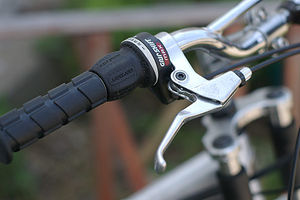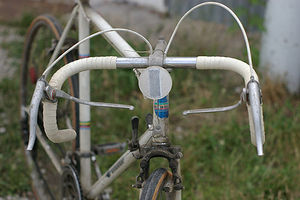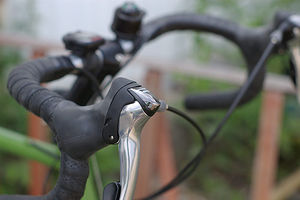Es posible que algunxs usuarixs de Firefox tengan que conectarse más de una vez para iniciar sesión. Es un error conocido de Firefox. Marca "keep me logged in" (mantenerme conectado), puede ayudar.
Handlebars: Difference between revisions
m (→See Also) |
m (→See Also) |
||
| Line 50: | Line 50: | ||
Steel bars go in the free parts room, up front by the loaner bikes. Aluminum bars go in the Limited Stock Room, near member parking, just inside the door (look up!). | Steel bars go in the free parts room, up front by the loaner bikes. Aluminum bars go in the Limited Stock Room, near member parking, just inside the door (look up!). | ||
== See Also == | == See Also == | ||
Revision as of 18:46, 30 November 2007
There are two types of handlebar, and it is helpful to be familiar with the difference when working on bikes.
This is because the two styles of handlebar are different sizes: they are made of different diameters of tubing. This means that they require different accessories and different brake levers, and are set up differently on bicycles. If you're working on a bike and you need to replace a brake lever, you will need to know where to look.
To the right are four examples of bar types, shown to give an example of what bars are likely to look like in practice, with brake levers and grips or tape on them.
First Type: Flat Bar
One type is known as a mountain bar, or flat bar. These bars are meant to be held at the end, where they have rubber grips.
Second Type: Drop Bar
The other type is known as a road bar, or drop bar. These bars are meant to be held anywhere on the bar, and are typically covered with some sort of padded tape. The bar tape is usually cork on modern bikes, but plastic or cotton was used on older bikes.
Many cheaper bikes will have no tape. The primary difference between these bars to the bicycle mechanic is that they require different brake levers. As is covered in the stem section, on very new bikes they may require different stems.
Important Points
- The older flat bar is not flat at all, but it does have grips.
- The brake levers on the old road bar have extensions that point inward - these are known as extension levers or safety levers.
- The old flat bar has a thumb shifter - the black thing near the brake lever, used to shift gears. The new flat bar has a shifter which is operated by twisting, labeled "Grip Shift" and located between the brake lever and the grip.
- On the old road bicycle, the shifters are on the downtube. On the new bicycle, the brake levers are also shift levers. This style is used on almost every modern road bicycle. Shifters will either be on the downtube or attached to the stem on road bicycles.
- You will find old flat bars on city bikes and cruisers. New flat bars are on all mountain bikes and some newer city bikes and hybrids. Road bikes will look more like the old road bars here than the new ones, except that many will not have extension levers.
- The old and new examples are only provided to show that not all bars of the same type look very similar. All road bike brake levers will fit all road bars, and all flat bar brake levers, shifters, and grips will fit all flat bars.
Sorting
Handlebars come in two materials and two types at the co-op. They are either made of aluminum or steel, and they are either flat bars or road bars.
Material
If a magnet will stick to the bar, it is still. Otherwise it is aluminum. You can't always tell by weight, or by finish, so be sure to use the magnet.
Shape
Road bars and flat bars are shaped differently - but be aware that flat bars are not always flat. There is more information in the article on ((Handlebars)).
Where they go
Steel bars go in the free parts room, up front by the loaner bikes. Aluminum bars go in the Limited Stock Room, near member parking, just inside the door (look up!).
See Also
Spanish
Manillar (f)



